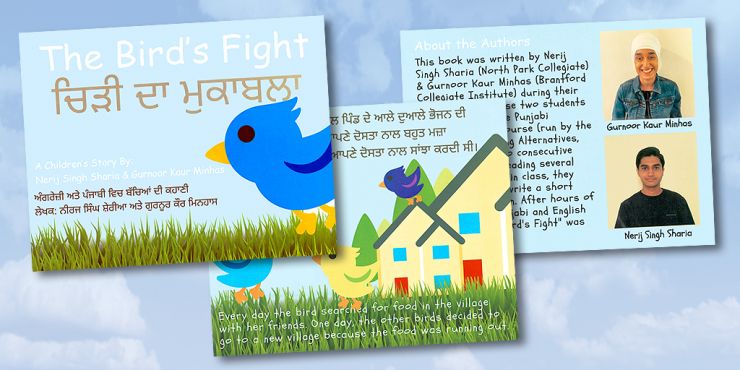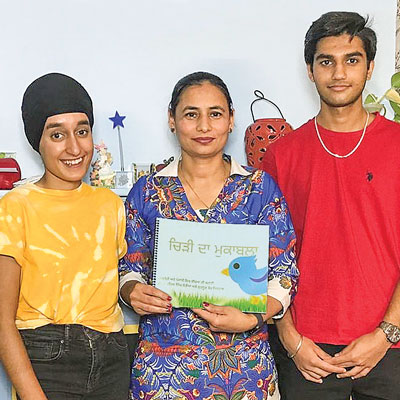
Above: A close-up of the book, which includes a narrative in both Punjabi and English.
Achieving and Inspiring through Storytelling
Reading books – and listening to books read out loud – can be a fun and effective way to master important skills when learning a new language. That’s why part of each secondary Punjabi language class includes teacher Palwinder Kaur reading a story to students.
“I read aloud in each class for students' listening abilities and speaking skills development,” says Kaur. “After the read aloud, students can share about the story, the characters, identify the problems that occurred, and what they learned from that story.”

Right:Teacher Palwinder Kaur, centre, poses with students Gurnoor Kaur Minhas and Nerij Singh Sharia (photo taken prior to Covid-19 restrictions).
After reading a variety of Punjabi-language children’s books, Kaur issued an assignment to students to write their own books, using the structures of character development, working through a problem, and imparting a lesson through storytelling. The assignment would have a cross-grade learning element as well, with a culminating activity that saw secondary students partnering with the Punjabi-language elementary class to share their own stories.
“I’ve always had a passion for writing; however, co-authoring a children’s book was never something I expected to be able to say I did by the end of the course,” said student Nerij Singh Sharia, a former North Park Collegiate student who completed the language credit in his final year of secondary school. “My goal was to reconnect with my culture and continue my passion for learning the language, and I’m pleased to have been able to share both in one final product.”
Sharia, along with fellow student Gurnoor Kaur Minhas, who attended Brantford Collegiate Institute and Vocational School, co-wrote The Bird’s Fight, a tale of teamwork between a bird and a dog who together overcome food scarcity in the village where they live. The authors spent hours working and reworking the storyline in English and Punjabi. Now the book has been printed, with help from Grand Erie Learning Alternatives (GELA) through which the language credit course is hosted.
The skill required to be able to master a task such as authoring a story in another language is a clear example of Grand Erie’s Multi-Year Plan Achievement indicator in action. This pillar of the plan includes setting high expectations for students, increasing an understanding of effective learning strategies in literacy, while monitoring, measuring and reflecting on outcomes. Both Sharia and Minhas have moved on to post-secondary school this year, and credit the Punjabi course with motivating them to continue studying the language – Minhas even landed a part-time job as a student ambassador with the University of British Columbia where she’s studying, and she says obtaining the language credit her final year of secondary school helped her land it.
The secondary credit course is normally held at Walter Gretzky Elementary School on Saturday mornings, and is currently being offered online. Books and storytelling continue to be a focus, as students sharpen their skills with sentence and grammatical structures. And as word of the course content and the students’ love of learning spreads, so does interest in enrolling. Kaur says that as the student-authors shared their experiences, students this year have been motivated to take the course and deepen their own knowledge and understanding of their heritage through language.
“They don't just learn Punjabi, they also inspire others to learn Punjabi.”
Photos by Grand Erie Communications
Healthy Bites Success for Graham Bell-Victoria Students
Graham Bell-Victoria School has been presented with a GOLD award of recognition and achievement in the Healthy Bites Program. The staff and students have worked hard and enjoyed the “fruits” of their labour as they have now been recognized with GOLD!
Throughout the year, Sonia Martin, school health nurse with the Brant County Health Unit, has lead our staff and students in a variety of healthy eating awareness activities. These included a Mystery Fruit and Vegetable contest, a trivia question in the monthly newsletter, and healthy fruit and vegetable snacks every Friday. These tasty treats, prepared by the grade 4-5 class were a big hit and helped us learn about the benefits of eating healthy.
Next year the program will be expanded to Healthy Steps and Healthy Bites, a program in which we will learn about and practice healthy eating and healthy activity. Congratulations, Graham Bell!
Voluntary Aboriginal Self-Identification
The Grand Erie District School Board recognizes the importance of school success for Aboriginal students. Our dedicated staff members are committed to improving services and programs for Aboriginal students attending school in the Board.
With a goal to improve the school experience for all Aboriginal students, the Board encourages the development of strong partnerships with Aboriginal families, communities and organizations, both on and off the reserve.
Through the Voluntary Aboriginal Self-Identification process, Aboriginal parents and students will have access to additional support services, including educational, social, and emotional supports that focus and foster Aboriginal identity, culture and values.
There are three categories of Voluntary Aboriginal Self-Identification – First Nation, Métis, or Inuit.
Your child may bring a GEDSB Voluntary Aboriginal Self-Identification form home or if not, you can contact your child’s school to receive a form. You can also, visit the Aboriginal Education section under the Program tab at www.granderie.ca for more information and a copy of the Voluntary Self-Identification form.
More News

